 Today, I want to discuss the pros and cons of carrying a revolver versus a semi-auto.
Today, I want to discuss the pros and cons of carrying a revolver versus a semi-auto.
That way, you can make an informed decision on this hotly debated topic.
Are there any Breaking Bad fans out there?
“If five rounds won’t get the job done, you’re into spray and pray, and another six isn’t likely to seal the deal. You can’t get more dependable than a wheel gun.”
Do you recognize those words of wisdom imparted to Walter White just before he bought his snub-nose 38 Special?
So maybe you’re considering your handgun choices for daily concealed carry, and the revolver has captured your eye.
You’re drawn to the simplicity, ruggedness, reliability, ergonomics, and even beauty of a wheel gun – but do they make good carry weapons?
In a day when most folks carry semi-autos with up to fifteen double-stacked rounds of 9 mm – what good is a five-shot revolver?
Actually, the revolver is a very good choice.
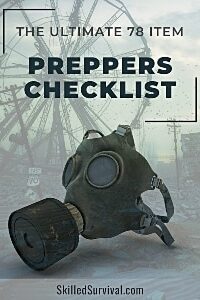
Want a free 78 item bug out bag checklist?
Enter your email below to instantly download this Complete Checklist PDF. No purchase necessary. 
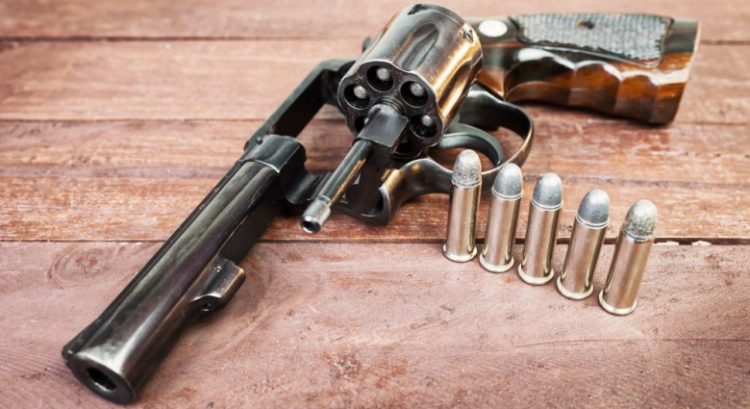
The Reliable Revolver…
One issue with semi autos is that they must be kept pristine and oiled to prevent their bad tendencies such as jamming during feeding or stove piping during extraction.
A little powder residue goes a long way to gumming up your semi-auto.
Suddenly, your fifteen-round 9mm becomes a single-shot weapon, while the small-frame revolver still has four more rounds.
Revolvers can take a little powder residue and still function.
In fact, it takes quite a bit of carbon build-up to jam up a revolver.
If you do not keep your weapons in a pristine condition (and you know who you are), you need to fight the urge to invest in weapons that require this level of care.
Or they may fail to function when your life depends on it.
Personally, I wouldn’t carry any weapon for self-protection in a dirty or neglected condition – make it a rugged revolver.
And it’s something to think about when it comes to survival guns…
One word of caution:
I’ve often heard the advantage of a revolver is if you have a misfire you can pull the trigger again to move another round into position for firing, unlike a semi-auto, where you will have to slide the rack.
This is true. However, keep in mind that if the revolver fails to fire because of a slow primer and you rotate the cylinder into the next position, you run the risk of an explosion.
Pulling the trigger again moves a dud out of the way, but a hang-fire may result in an out-of-battery explosion, destroying the gun and whatever human parts happen to be in the way of the flying metal.
Again, it’s nice to have a double stack of 9mms, but you have to hit the target.
And – by the way – we talk a lot about 15-round capacities and double-stacked magazines, but let’s get real for a moment.
These full-frame pistols conceal carry with all the subtlety of an ISIS pick-up truck.

Revolver vs Semi-Auto Accuracy
Many semi-autos suffer from accuracy issues due to several factors.
During firing, the explosion of gases from the cartridge forces the slide rearward, extracting the spent cartridge on the recoil and grabbing a new cartridge from the magazine during the return to battery.
The bullet is moving down the barrel when the recoil begins.
This recoil consists of a mass of metal slamming rearward.
The vibration and jolting forces imparted to the shooter’s hand and the barrel itself during this recoil can shift the barrel’s alignment slightly, especially in guns with “floating” barrels or barrels that are not fixed.
Floating barrels are used on higher-power locked-breeched pistols.
This is due to the higher chamber pressures associated with them. The barrel locks into the slide by pressure until the pressure drops enough to unlock and allow the slide to function.
This is necessary for the safe operation of the pistol.
Without this locking breech function, the higher chamber pressures would slam the slide backward hard enough to damage it and possibly cause the cartridge to explode rather than contain the pressure until the bullet leaves the barrel.
This locking and unlocking of the barrel causes a very slight movement in barrel alignment as it locks and unlocks.
The sights on a semi-auto pistol are also integral to the slide, the large moving part of the weapon, rather than a fixed barrel.
Another problem with the 9mm semi-auto accuracy is the people who shoot them. When you have over a dozen rounds in a fast-firing semi-auto, you tend to spray and pray.
This is what occurs when you read about those cases of gunfights where dozens of rounds were shot from near point-blank ranges by both parties, and neither was hit – or several bystanders were hit by accident.

Spraying And Praying Is A Quick Way To Die
Any self-defense instructor worth their salt will tell you that you bring the weapon up and out so you are looking down the sights while firing – unless you are in very close quarters – like knife fighting close quarters.
The sights are there to aim the weapon – use them – and learn to use them quickly.
Having only five rounds in your weapon forces you to consider the value of each shot, and you may aim accordingly.
So maybe you’ve heard revolvers are inherently accurate. Revolvers have fixed sights integral to the barrel – which is also integral to the frame.
They do not move – at all.
Firing a single action, the revolver’s accuracy does not suffer from jolts and vibrations of a recoiling mass of metal or a floating or tilting barrel.
That being said, although there are no moving parts subject to the forces of recoil, the weapon’s recoil is more easily felt when firing a revolver.
The recoil, or kick, tends to be absorbed by the moving mass of the slide in a semi-auto, so the shooter doesn’t feel the kick as much as in a revolver.
The actual energy of the explosion is the same, but due to the motion of the slide and return spring, the force is distributed over more distance and time, reducing the “impact” of the recoil.
The big difference is this:
The recoil might feel larger in a revolver, but the gun itself is rock solid, and the barrel alignment is not affected by any mechanical forces in the weapon’s action.
By the time the recoil moves the weapon into the shooter’s hand, the bullet has already left the barrel.
Old military instructors tell us to “just let the barrel rise on the recoil. Don’t fight it.”
If you try to anticipate the recoil of a revolver, you’ll wind up pushing the barrel downward and shooting low.
Some trade-offs exist:
More weapon movement in a semi-auto but more felt recoil in a revolver.

Want a free 78 item bug out bag checklist?
Enter your email below to instantly download this Complete Checklist PDF. No purchase necessary. 
How Do We Fix This?
Simple. Leave your .44 Magnum at home and carry a 38 Special.
There is very little recoil from these cartridges, but you still get 158 grains of copper flying death at 850-1000 feet per second or more.
If you want no recoil – go with a .22 LR or, even better, the .22 Magnum – usually in a revolver with 8 shots.
Yes, small bullets, but more of them. And no recoil and pretty darn good accuracy.
Still, I’m not a .22 man, myself.
Maybe it’s because my mother carries a .22 LR revolver…
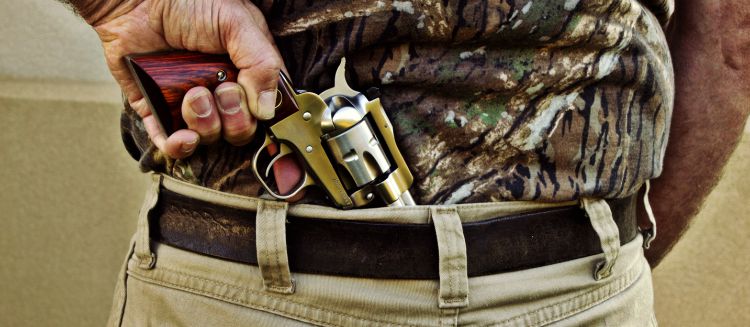
Let’s Consider Concealed Carry
Revolvers, while having rounded edges, are straight-up fatter weapons.
The geometry of the revolver is simple: it has to be wide enough to accommodate the width of three bullets, the one in firing position and essentially one on each side of the circle, as well as the thickness of steel designed to contain the pressure of the explosion.
The traditional six-shooter is not a good conceal-carry weapon—the cylinder is just too big. So manufacturers solved the problem by dropping a bullet and reducing the spacing, making for a smaller cylinder.
Note: this doesn’t apply to the .22 caliber revolvers.
The bullets and chamber pressure make for a small cylinder. But if you want any power approaching an equivalent 9mm Luger, you can only have five shots, traditionally in 38 Special or .357 Magnum.
Single stack 9mm semi-autos can be very thin by comparison.
Now, remember my previous comments? I’m not talking about the full-framed 15-round Wonder-Nines.
I’m talking the 6-7 shot single stack weapons, like my Walther PPK , a Smith and Wesson Body Guard , or a Kimber Micro 9.
These semi-autos are thin and conceal better than a comparable revolver.
They don’t print nearly as easily and are more comfortable to carry.
Comfortable” is a very relative term in the concealed carry business, equating to almost anywhere on the body.
Such as in the waistband, small of the back, ankle holster, etc.
The only place it doesn’t have an advantage in this regard is in a woman’s purse.
You notice, though, if talking about a single stack 9mm or .380 auto, you’re talking about a six-shot magazine and maybe one more in the pipe.
Not that much more than the revolver.
The risk/reward of this is two extra shots balanced against a possible failure to feed or failure to extract.

Want a free 78 item bug out bag checklist?
Enter your email below to instantly download this Complete Checklist PDF. No purchase necessary. 
Now, What About Single Versus Double Action?
Revolvers with exposed hammers can be fired either single or double action.
Single action means you have to cock the hammer.
The advantage here is the single-action trigger pull is usually less than 4 lbs. and your beefy finger won’t pull the weapon off target during a heavy trigger pull.
Double action means the hammer is not cocked, or you have a striker-fired weapon, and the trigger pull itself cocks and fires the weapon in a single stroke.
The trigger pull of a DAO semi-auto is definitely heavier than that of a single-action revolver, but it is also typically much less than that of a double-action revolver.
In a revolver, that double action has to pull back the hammer and rotate the cylinder, and it can be a hefty pull, throwing off your aim.
So here’s the Catch-22: single action, a quality revolver’s accuracy is hard to beat. However, when shot with double action, it’s probably worse than any semi-auto using double action only.
To be fair, though, many SA/DA semi-autos with exposed hammers have heavy double-action pulls for that first shot. The trigger pull has to cock the hammer.
That first shot racks the slide and re-cocks the hammer so that the follow-up shot will have a very light single-action pull.
On the other hand, some DAO semi-autos, like Glocks, are striker-fired, and their double-action trigger pulls are pretty darn light.
I don’t like them. The trigger pull just doesn’t feel right to me, but many people like them and they can be very accurate in the right hands.
Just not my hands.

The Question: What’s Your Technique?
Are you going to fire single action or double?
But what about exposed hammers versus guarded hammers on a revolver?
Some small-frame carry revolvers have guarded hammers. The hammers are only visible when “staging” the trigger.
This involves applying slow, gradual pressure to the trigger to rotate the cylinder and slowly bring the hammer back.
You can be more accurate in that first shot if you see the hammer move. You’ll have a feel for when it will break.
Supposedly, they designed these weapons in this manner to avoid the exposed hammer catching on the insides of a woman’s purse or perhaps in a jacket pocket.
Personally, I wouldn’t own one.
To me, they are great Mafia guns… perfect for jamming a pistol into someone’s stomach in a dense subway crowd.
Or for Michael Corleone to shoot the cop eating spaghetti across the table from him.
This Begs The Question: In What State Are You Going To Carry?
By state, I don’t mean New York, Texas, or Tennessee – I mean the state of the weapon.
If you have a revolver, it’s a no-brainer. You will have five rounds in the cylinder – one of which is always in firing position.
Most revolvers have no safety. If you don’t want to shoot – don’t pull the trigger.
Modern revolvers also have an internal safety bar which prevents the firing pin from striking the primer if you drop the gun right on the hammer.
They basically block the firing pin unless you cock it.
Now, you could carry it with the hammer cocked if you want to blow your foot off. With the hammer cocked – that trigger pull gets really light.

But What About Semi-Autos?
It depends on the design of your weapon and your personal choice. Some people carry a bullet in the chamber; others carry an empty chamber.
- If you carry one in the pipe, you increase your capacity from six shots to seven.
- If you carry with an empty chamber you’ll have to slide the rack when you draw.
Some people are comfortable with this, others not so much.
My little Kel-tec .380 semi-auto has no safety. It relies on a double action pull to act as a safety.
I carry it with the chamber empty.
My Walther PPK .380 is both single and double action.
I can load a round into the chamber then hit the decocker/safety lever.
This little lever decocks the hammer and blocks it from the trigger.
When drawn, I simply flip the little lever up, taking the safety off, and then I have two choices.
I can either manually cock the hammer, giving me a very light trigger pull, or I can just squeeze the trigger harder, and the hammer will cock and fire double action.
I carry this one with one in the chamber and six in the magazine, with the decocker/safety engaged.
Many double-action only semi-autos are carried with a round in the pipe and the safety on.
Flip off the safety, and you are ready to rock and roll. No need to rack the slide again and no hammer to cock – these have internal strikers.
Some semi-autos allow for the cocked and locked condition.
This means there is a round in the chamber, the hammer is cocked fullback, but the safety lever, usually flipped up, simply blocks the trigger and prevents the fall of the hammer.
In this configuration, the weapon can be drawn, the lever flipped down and the trigger pulled immediately in single action.
Many people carry this way. Many do not.
Some people aren’t comfortable carrying a cocked weapon, even with the safety engaged.
Which Is Right For You?
So there are lots of choices.
- Revolver vs semi-auto?
- Caliber? Single action, double action, or both?
- Exposed hammer, guarded hammer, or striker fired?
- Carry with chamber full or chamber empty?
- Decocker? Cocked and locked?
Then, of course, where are you going to carry it?
- Purse? Ankle?
- In the waistband?
- Out of the waistband?
- Small of the back? In a pocket?
Based on my comments above, you are probably wondering why I don’t carry a revolver if I love them so much.
For me, I like the slim, easy-to-carry outline of my Walther—as well as the extra two shots.
But the little Smith and Wesson Airweight is perfect for a purse.
It boils down to what is right for YOU.
What are you comfortable with? You need to be comfortable with the mode of carry and confident in the manipulation and operation of the firearm.
Any or all of these choices are valid, but you must find the optimum combination for you.
Why Trust Skilled Survival…
Go here now to review a full breakdown of:
- Who We Are
- Our Credentials
- Our Mission
- & Product Recommendations…
Here are a few highlights of our teams credentials & certifications:
- Certified Member of a Mountain Search & Rescue Organization
- Plant Emergency & Safety Leader for a Major Food Manufacturer
- Member of the 10TH Mountain Division Hut Association
- Certifications: Avalanche 1, WFR, CPR
- Official Gear Tester for Numerous Outdoor Gear Companies
- Countless Multiday Backpacking trips into Remote Wilderness
- Bachelor’s Degree In Mechanical Engineering
- Bachelor’s Degree In Civil Engineering
- Bachelor’s Degree In Biomedical Engineering
“It takes 20 years to build a reputation and five minutes to ruin it.” – Warren Buffett
We’re fully aware that trust is NOT something you GET but is EARNED.
And we’ll continue to earn YOUR trust through our forthright and honest approach with each new Blog Post, Guide & Product we create…
Prepare, Adapt & Overcome,

P.s – I just took this FREE 60-second ‘Readiness Score Quiz’
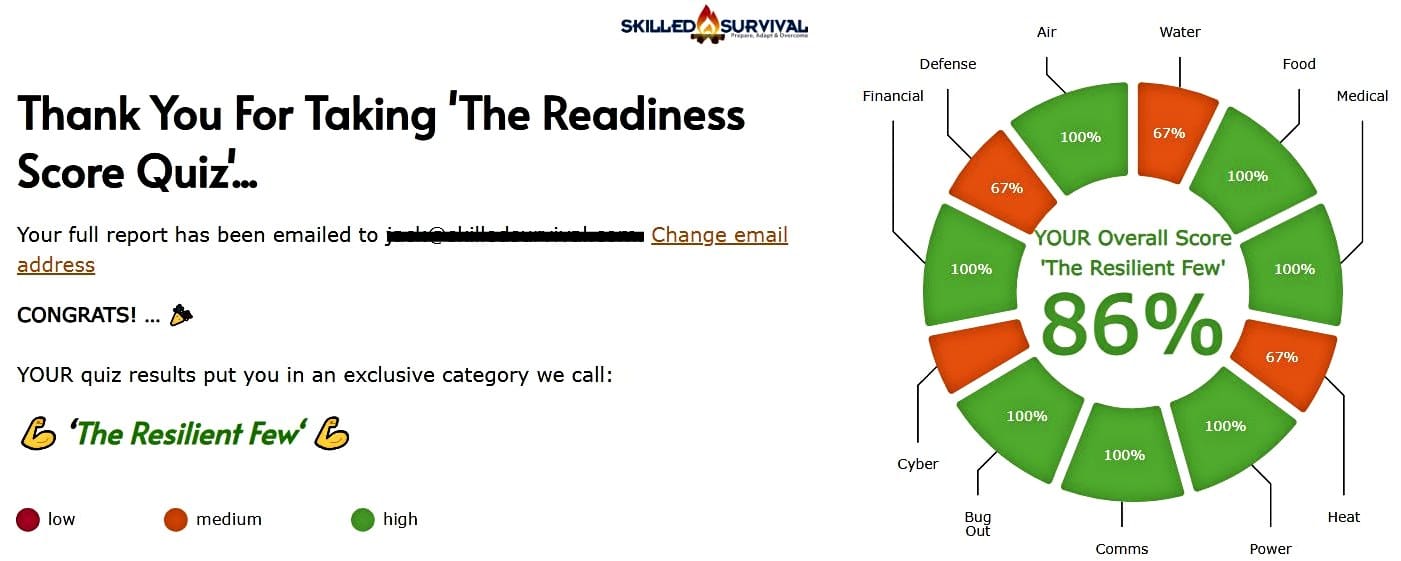
AND… I’ve still got a few gaps in my preps…
But at least, I’m not part of ‘The Fragile Masses’.
Find out where YOU stand by answering a few questions…
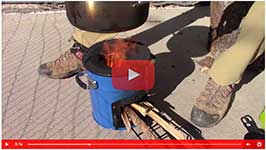

Get My 10 Steps To Basic Preparedness Video For FREE.
Plus daily survival tips (unsubscribe anytime).
Read the full article here














Leave a Reply